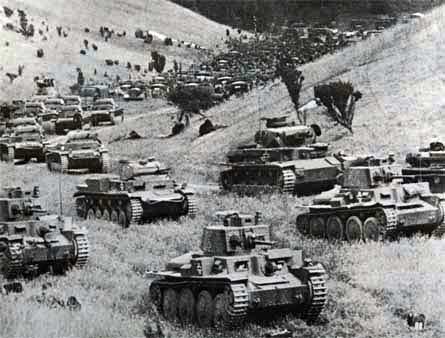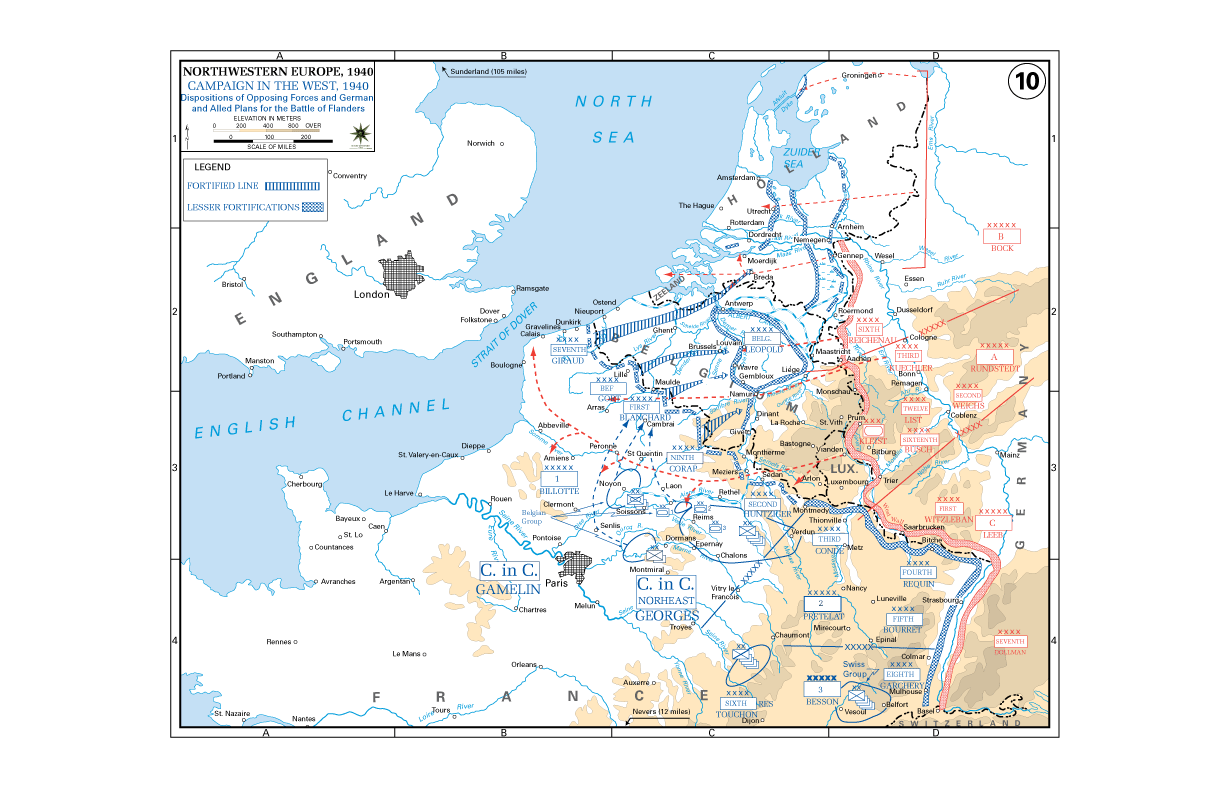| 1940: The Blitzkrieg Legend
Comparative War Planning, Part One
By Vincent Kamer
January 2023
So what is it all about?
Time has moved on since the dramatic events of May 1940. Time enough for all the facts to have come to the table; there are no more dramatic or new sources becoming available. Still there is much discussion on what the facts tell us. As we commemorate the events of 75 years ago, old newsreels with Panzers and Stukas descending on the hapless Allied Forces flash by on our screens and people remember the stories how the Nazi war machine released a surprise Blitzkrieg and brought the Belgian and French Armies to their knees in a matter of weeks, with the British forces only escaping by the miracle of Dunkirk, to live to fight another day.

So you're saying this is the wrong image to use here?
Between historians these simplistic images have given way to a more sophisticated debate on the reasons for the swift defeat. But even in the 21st Century there is no consensus, evidenced by the fact even until very recently different authors are coming to very different conclusions.
In the highly acclaimed book “The Blitzkrieg Legend” by the German Colonel Karl-Heinz Frieser, first published in 1995, the conclusion can be quoted as follows:
After the disaster at Sedan, the French supreme commander Gamelin gave Winston Churchill three reasons for his army’s defeat: “Inferiority of numbers, inferiority of equipment, inferiority of method.” But today we know that only the third reason was accurate. It had to do with the tactics that were used in employing the troops.”
The famous 1940 blitzkrieg, however, had not been planned as a blitzkrieg. An investigation into the preparatory measures prior to the campaign in the west, particularly in the field of armament, clearly shows that the German command was planning a rehash of the many long years of struggle during World War I. To that extent, it was completely surprised by the course of operation. The “miracle of 1940” cannot be traced back to a blitzkrieg strategy that is repeatedly played up largely in historiography.
Compare that with the conclusion of an equally impressive work of research by the French General Bruno Chaix in En Mai 1940, fallait-il entrer en Belgique? published in 2005: “C’est que les deux stratégies qui s’affrontent ne font pas jeu égal, les Allemands à presque tous les niveaux stratégiques, l’emportent par leur direction, leur doctrine et leurs moyens. Dès lors, autant la qualité de leur outil permettait aux Allemands de prendre tous les risques, autant la faiblesse de notre préparation laissait peu de chances à n’importe lequel de nos plans opérationnels.”
On a more personal level I have been interested in the history of the Second World War since my early teens – clearly as a result of my family history, of which more later. For nearly 40 years I have extensively read on the subject, discussed and wargamed it (and am wargaming still) for hours and days with my friends, including all major engagements – both tactically, operationally and strategically. My library of books and games has grown in size well beyond what my dear wife, God bless her, is comfortable with. It seemed only appropriate to apply this accumulated knowledge in analysis.
The purpose of this case study is to analyze in broad terms the different arguments and illustrate it in more detail based on a very significant part of that battle – the confrontation of the German Fourth Army against the French Ninth Army from 10th to 15th of May 1940 in the Belgian Ardennes.
I have a wicked plan!
Baldrick – servant to Lord Black Adder
There is a large consensus that the German War plan was a very inventive if high-risk undertaking. Germany wanted and got the strategic initiative of attack, which in turn allowed it to prepare and concentrate troops and resources in a way it saw as most advantageous to itself and try and gain surprise on the Allies. What is much less known to the general public is that the final plan of attack, the famous “Sichelschnitt,” was only adopted in early 1940 after significant parts of the previous plans had been captured inadvertently by the Belgians when a German plane with those plans came down in thick fog in a still-neutral Belgium. The Belgians passed these promptly on to the French, causing what has been called the “January crisis.”

Planning is everything.
It is only in that latest version of the German war plan that the extreme concentration, particularly of Panzer and air forces, in the Ardennes was called for with the follow-up exploitation to the Channel coast and encirclement of the main body of Allied forces in Belgium and Northern France. To achieve maximum odds, large amounts of troops were initially positioned in such a way that the area they intended to strike strike – north or south of the Ardennes - could not be fully determined. This was combined with a final concentration plan which demanded that these troops reach their final destination for attack within 12 hours after the final order for the commencement of offensive operations had been given. While some surprise was certainly achieved, it was relatively short-lived and was not enough to determine the final outcome.
There is the same level of consensus that the Allied war plan had serious shortcomings. The most damning one, in my opinion, is the fact that Belgium, despite all the evidence of imminent attack, clung stubbornly to its neutrality policy and steadfastly refused to allow French and British troops access to its territory. With four additional armies dug in behind the Albert canal, Liège fortress and the Ardennes, no “Sichel” would have “schnitt.”
The Allies were by definition a coalition in which each had their ideas, but with France by far the largest contributor of forces it got to sit in the driver’s seat. There was an overall strategic coordination in what became the final version of the Dyle Plan – Breda variant. The Belgian Plan called for demolitions and rapid withdrawal from the Ardennes, and would concentrate their army along the KW (lightly fortified) line between Fortress Antwerp (Koningshooit = K) and Leuven. The British Expeditionary Army would extend the KW position from Leuven to Wavre (=W) behind the (lightly fortified) Dyle river. The French then took over from Wavre to Namur behind some antitank obstacles, and from there on behind the Meuse into France proper, where it joined up with the famous Maginot line (heavily fortified naturally).
Since Belgium would not allow troops on its territory it follows that these French and British forces would have to arrive very speedily after the German offensive commenced – an operation with some risk. Nevertheless it was in essence a sound plan, shortening lines by about 250 kilometers and placing them pretty much everywhere either behind rivers or some level of fortification – with a buffer zone in front of that to buy time to get everyone into place. For some totally non-military reason Gamelin, the French commander-in-chief, in November 1939 then added a Breda variant in which one Army was dispatched north of Antwerp to “sort of” link up with the Dutch in a what militarily speaking was clearly a faux pas.
In any case neither General von Kluge (commander of the German 4th Army), nor General Corap (commander of the French 9th Army) had any opportunities to change the war plans. They were assigned their part.
 Fourth Army was to participate in the Sichelschnitt as its northern prong. Just like its much larger southern cousin it was an ambitious operation, in which it first had to cover an even longer path from the Belgian-German border through the Ardennes (some 130 kilometers) while also crossing the Ourthe river, and then cross the Meuse between Givet and Dinant. The objective was to do this in two to three days. Following that it was to break through to the Belgian-French border and beyond, and in doing so to shield the southern prong from attacks from the North. Fourth Army was to participate in the Sichelschnitt as its northern prong. Just like its much larger southern cousin it was an ambitious operation, in which it first had to cover an even longer path from the Belgian-German border through the Ardennes (some 130 kilometers) while also crossing the Ourthe river, and then cross the Meuse between Givet and Dinant. The objective was to do this in two to three days. Following that it was to break through to the Belgian-French border and beyond, and in doing so to shield the southern prong from attacks from the North.
Ninth Army was an integral part of the Dyle Plan, a smaller version of what was asked of the main forces further north. It had to push up from its starting positions inside France to form a new defensive position on the Meuse about 60 kilometers from the border between Namur and Givet (in France), while also holding the Meuse in France from Givet to La Bar. Once it had secured the river, it was to hold that position. Using reconnaissance forces to screen Ninth Army, the plan assumed the army had five to nine days before seeing German forces appear – if any, as the assumption was that the main body of the German attack would be further north through Belgium as in World War One.
The combination of the “Sichelschnitt” with the “Dyle-Breda variant” gave a higher possibility of success to the German plan, as it took significant allied resources away from the path of attack chosen by the Germans (see map), but would that be enough? The meeting of the Fourth Army and Ninth Army can in some way be compared to a mini-version of the much larger scheme. It also allows for much more detailed comparison.
You can order 1940: The Fall of France right here.
Please allow an extra two weeks for delivery.
You can order 1940: The Last Days of May right here.
Please allow an extra two weeks for delivery.
You can order Road to Dunkirk right here.
Sign up for our newsletter right here. Your info will never be sold or transferred; we'll just use it to update you on new games and new offers.
Want to keep Daily Content free of third-party ads? You can send us some love (and cash) through this link right here.
|
